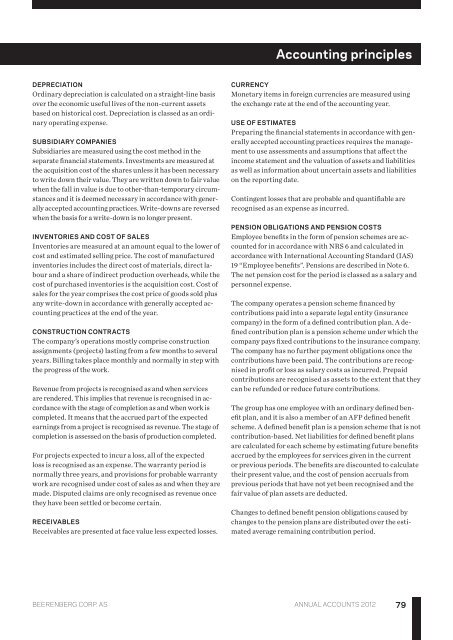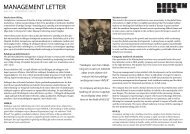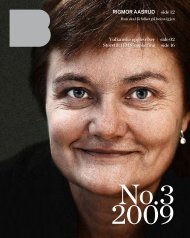Note 1 - Beerenberg
Note 1 - Beerenberg
Note 1 - Beerenberg
Create successful ePaper yourself
Turn your PDF publications into a flip-book with our unique Google optimized e-Paper software.
Accounting principles<br />
Depreciation<br />
Ordinary depreciation is calculated on a straight-line basis<br />
over the economic useful lives of the non-current assets<br />
based on historical cost. Depreciation is classed as an ordinary<br />
operating expense.<br />
Subsidiary companies<br />
Subsidiaries are measured using the cost method in the<br />
separate financial statements. Investments are measured at<br />
the acquisition cost of the shares unless it has been necessary<br />
to write down their value. They are written down to fair value<br />
when the fall in value is due to other-than-temporary circumstances<br />
and it is deemed necessary in accordance with generally<br />
accepted accounting practices. Write-downs are reversed<br />
when the basis for a write-down is no longer present.<br />
Inventories and cost of sales<br />
Inventories are measured at an amount equal to the lower of<br />
cost and estimated selling price. The cost of manufactured<br />
inventories includes the direct cost of materials, direct labour<br />
and a share of indirect production overheads, while the<br />
cost of purchased inventories is the acquisition cost. Cost of<br />
sales for the year comprises the cost price of goods sold plus<br />
any write-down in accordance with generally accepted accounting<br />
practices at the end of the year.<br />
Construction contracts<br />
The company’s operations mostly comprise construction<br />
assignments (projects) lasting from a few months to several<br />
years. Billing takes place monthly and normally in step with<br />
the progress of the work.<br />
Revenue from projects is recognised as and when services<br />
are rendered. This implies that revenue is recognised in accordance<br />
with the stage of completion as and when work is<br />
completed. It means that the accrued part of the expected<br />
earnings from a project is recognised as revenue. The stage of<br />
completion is assessed on the basis of production completed.<br />
For projects expected to incur a loss, all of the expected<br />
loss is recognised as an expense. The warranty period is<br />
normally three years, and provisions for probable warranty<br />
work are recognised under cost of sales as and when they are<br />
made. Disputed claims are only recognised as revenue once<br />
they have been settled or become certain.<br />
Receivables<br />
Receivables are presented at face value less expected losses.<br />
Currency<br />
Monetary items in foreign currencies are measured using<br />
the exchange rate at the end of the accounting year.<br />
Use of estimates<br />
Preparing the financial statements in accordance with generally<br />
accepted accounting practices requires the management<br />
to use assessments and assumptions that affect the<br />
income statement and the valuation of assets and liabilities<br />
as well as information about uncertain assets and liabilities<br />
on the reporting date.<br />
Contingent losses that are probable and quantifiable are<br />
recognised as an expense as incurred.<br />
Pension obligations and pension costs<br />
Employee benefits in the form of pension schemes are accounted<br />
for in accordance with NRS 6 and calculated in<br />
accordance with International Accounting Standard (IAS)<br />
19 “Employee benefits”. Pensions are described in <strong>Note</strong> 6.<br />
The net pension cost for the period is classed as a salary and<br />
personnel expense.<br />
The company operates a pension scheme financed by<br />
contributions paid into a separate legal entity (insurance<br />
company) in the form of a defined contribution plan. A defined<br />
contribution plan is a pension scheme under which the<br />
company pays fixed contributions to the insurance company.<br />
The company has no further payment obligations once the<br />
contributions have been paid. The contributions are recognised<br />
in profit or loss as salary costs as incurred. Prepaid<br />
contributions are recognised as assets to the extent that they<br />
can be refunded or reduce future contributions.<br />
The group has one employee with an ordinary defined benefit<br />
plan, and it is also a member of an AFP defined benefit<br />
scheme. A defined benefit plan is a pension scheme that is not<br />
contribution-based. Net liabilities for defined benefit plans<br />
are calculated for each scheme by estimating future benefits<br />
accrued by the employees for services given in the current<br />
or previous periods. The benefits are discounted to calculate<br />
their present value, and the cost of pension accruals from<br />
previous periods that have not yet been recognised and the<br />
fair value of plan assets are deducted.<br />
Changes to defined benefit pension obligations caused by<br />
changes to the pension plans are distributed over the estimated<br />
average remaining contribution period.<br />
<strong>Beerenberg</strong> CORP. AS Annual accounts 2012<br />
79












